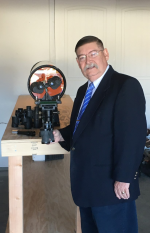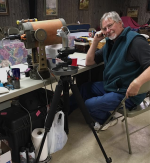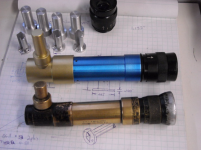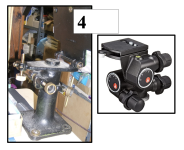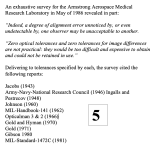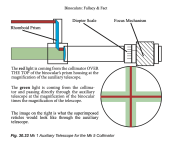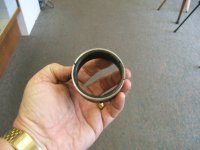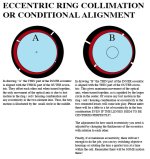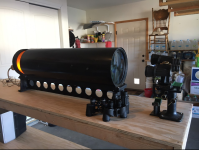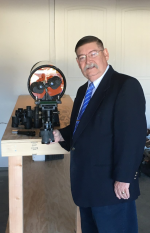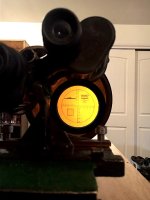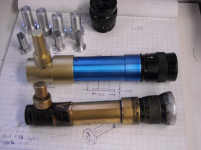Your book suggested using a Fresnel lens, which turned out not to work. It also says a lens made from inexpensive glass will work (since color correction is irrelevent), but I have been unable to find an 8" or larger example. You also mention that a telescope will work, but I presume that the lens diameter must be a bit larger than the distance between the outer edges of the binocular objectives, so both lenses see the target. I guess that implies 8" minimum for 7x50 size porros? Such telescopes are very expensive. So I can't build a Mark V collimator yet.
Exactly what sort of work would need to be done to a telescope, instructions aimed at a non-telescope builder? Inserting the reticle target into the tube. Perhaps one could purchase a crosshair or reticle disc that would fit into or just ahead or behind the eyepiece? I suppose a flashlight behind the eyepiece would suffice for illumination? Could the modifications be of a temporary nature so a borrowed telescope could be returned to its normal condition?
TIA
“Your book suggested using a Fresnel lens, which turned out not to work.”
“Yep, even I who disparages so many “experts.” No doubt ... there are many clueless EXPERTS! Normally, I am clever enough to see through the majority of these. This time, I stumbled. Actually, I don’t see how a Fresnel lens WON’T work. In most of these situations, I make one of whatever is in question. This time, I didn’t; sorry ‘bout that! Also, there is much more going on in my old life that seems ready to keep me from getting wrapped around the axle. Yes, for the purist, chromatic aberration would be a problem. Birdforum is full of posts from people who want to spend money
UPGRADING when, most of the time, they—here in the REAL world—cannot realize the difference. They maybe more enamored in the different field of view, the weight, the looks, the feel, or any number of OTHER things that make them choose another.
For example the inexperienced talk of:
clear, crystal clear, soft, blurry, mushy, tact sharp, brilliant, spot on, high contrast, contrasty, and on and on. These are terms used by the optically untutored but they mean absolutely
NOTHING in the real of optical engineering in which terms must be quantified as opposed to the massively
SUBJECTIVE terms presented above.
“It also says a lens made from inexpensive glass will work (since color correction is irrelevant), but I have been unable to find an 8" or larger example.”
In the large lens category: If you look around at some surplus optical warehouses, you can probably find what you are looking for. MY recommendation would be to start with
Surplus Shed of Fleetwood, PA. Their offerings come and go; be patient ... if you MUST have a lens. They have been providing used optical gear for years. Also, some people use large aerial surplus camera lenses. Years ago, Edmund Scientific would be a great source. They got their start be purchasing tons of optical gear used in World War II. Alas, ES changed their business model years ago.
“You also mention that a telescope will work, but I presume that the lens diameter must be a bit larger than the distance between the outer edges of the binocular objectives, so both lenses see the target. I guess that implies 8" minimum for 7x50 size porros? Such telescopes are very expensive. So I can't build a Mark V collimator yet.”
Part of what you say is right on; another part is a bit misguided:
“Such telescopes are very expensive.”
That could be true if you have to have a new
LENS. In specifying telescope. I said nothing about a lens. A Newtonian telescope will work fine and those grow on trees.
Even a catadioptric would be fine ... and convenient. The aperture would need to be big enough to cover
MOST of the spread of the objective lenses of the binoculars.
The first attachment
(1) is me and my Mk5. As you can see, the aperture is broad enough to handle the bino quite well. But, I have used it on much larger binoculars. A perfect fit is unnecessary.
The next attachment
(2)is Cory at a star party with his C-8. I don’t think he uses a reticle. But remember, the reticle is only a convenience.
YOU’RE JUST TRYING TO SUPERIMPOSE TWO DOTS OF LIGHT. What could be easier than that? And considering our spatial accommodation, if the images a very close that might be all you need—without any eyestrain!
Of course, you will need a low-power auxiliary scope. I use one made by Cory. One attachment
(3) shows the original in the foreground and one of Cory’s right behind it. Attachment
(6) shows am auxiliary scope made by Australian optician, telescope maker and friend Roger Davis. People with no more skill than you can make them. I think Archimedes could have made one ... in his sleep. Attachment
(7) illustrates how they work.
Also attached is the heavy test stand
(4) —made of cast iron and brass. If you don’t happen to have one of those in your hip pocket, you can find any number of alternatives at your local camera store.
“Exactly what sort of work would need to be done to a telescope, instructions aimed at a non-telescope builder? Inserting the reticle target into the tube. Perhaps one could purchase a crosshair or reticle disc that would fit into or just ahead or behind the eyepiece? I suppose a flashlight behind the eyepiece would suffice for illumination. Could the modifications be of a temporary nature so a borrowed telescope could be returned to its normal condition?”
I would suggest something a little more sophisticated than a flashlight—my Mk5 will be up for sale later this year. But suit yourself. If you had an eyepiece with a reticle—or even a piece of cardboard with a pinhole, you could
borrow the scope, insert your own EP (with reticle or pinhole, and return the scope when finished. I can tell by some of the things you have said that you have the smarts and the desire to make a working setup, but ...
(5). If there is one thing I’ve learned from all this collimation talk, it’s that too many people are doing themselves a great disservice by thinking themselves to death!!! They think they must have perfection in collimation. I have collimated something over 12,000 binoculars, but I have NEVER collimated one to perfection. It can’t be done. Temperature and humidity won’t allow it ... except in the minds of those who have much more by way of opinion than fact. Please read attachment 5 again.
“If you can’t explain it simply, you don’t understand it well enough.”— Albert Einstein
Kevin Busarow has been an acquaintance and friend for many years. But while he is a caring salesman and optical hero to many, I use the following to say that all that glitters is not gold. The following is a snippet from a previous letter.
Kevin Busarow and Oberwerk
There is a little more to 3-Axis collimation than having a jeweler's screwdriver. You have drawn information from Oberwerk. Well, let me tell you a story about Oberwerk.
A Story: OM1 Cory Suddarth (S.O.R, Suddarth Optical Repair) worked with me aboard USS Grand Canyon and for me (OMC Cook) for about 7 years at Captain's in Seattle. Knowing Kevin Busarow (owner of Oberwerk), we TRIED to get him to understand the difference between binocular collimation (opto-mechanical) and Conditional Alignment (physiological, based on the observer's level of spatial accommodation). When Kevin saw me ON CLOUDY NIGHTS trying to raise the bar of understanding, he apparently thought I was somehow trying to hurt his business and produced 2 videotapes for sale showing how conditional alignment was a "myth," stating that he could, "collimate a binocular to 100-power by eyeballing it."
Kevin backed off a little when professors at the College of Optical Sciences at the University of Arizona and leaders of SPIE invited me to lecture on the subject at their 2012 San Diego convention.
But then, with Cory doing much of his repair and collimation work, he went to one of his Collimation with a Mk 5 Collimator seminars and learned what we had been trying to tell him for over 15 years. After that, he purchased a Mk 5 collimator that I had sold to a company in southern California. Now he knows, "Conditional Alignment" isn't a myth and is taking full advantage of the collimator that he swore he "didn't need."
PS All of the attachments had a number on them. Apparently though, the computer geeks who rule the world thought (4) and (5) would be enough for you!
"If you took all the would-be computer geeks in the world and laid them end to end it would be a good thing ... at least if they were deep enough!" — BC








